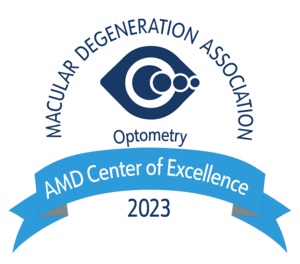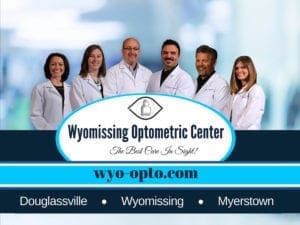Leading the Way in Macular Degeneration Treatment
What is Macular Degeneration?
AMD is a common eye condition and the leading cause of permanent vision loss among people aged 60 and older in the US. It causes damage to the retina, the nerve lining the inside of the eye. The macula is the center part of the retina and is needed for sharp and detailed vision, which lets us see objects that are straight ahead.
During a dilated eye examination, the first visible sign of AMD is the presence of small waste deposits in the macula called drusen.
Advanced AMD can cause permanent loss of central vision in one or both eyes. As AMD progresses, a blurred area in the center of vision develops. Over time, the blurred area may grow larger or you may develop blank spots in your central vision. Objects also may not appear to be as bright as they used to be and may become distorted.
AMD does not lead to complete blindness, with black vision and no ability to see. However, the loss of central vision in AMD can severely impact everyday activities, such as the ability to drive, read, write or distinguish details on people’s faces.
Risk factors
- Age. The disease is most likely to occur after age 50 and risk increases with each decade.
- Smoking. Research shows that smoking triples your risk of developing AMD and increases the risk of vision loss by 3-4 times compared with non-smokers. If you quit smoking, the risk decreases over time but is dependent on the length and amount of cigarettes smoked over your lifetime.
- Race. AMD is more common among Caucasians.
- Family history. People with a family history of AMD are at higher risk of developing the disease.
- Obesity. Research shows those with normal BMI and an active lifestyle have reduced risk of AMD progression.
- Uncontrolled high cholesterol, high blood pressure, diabetes. If uncontrolled, each condition increases your risk of advancing AMD by 20%.
- Unhealthy diet. Diets high in saturated fats and low in fruits and veggies are more likely to have advancing AMD than those with a healthful diet.
Lifestyle choices that reduce risk of AMD development and progression
There is a definite link between AMD and certain lifestyle decisions. You can reduce your risk of developing AMD or slow its progression by making these healthy choices:
- Avoid smoking. If you currently smoke there are many resources online and in person, or discuss with your primary care doctor about options that can help you quit.
- Exercise regularly. At minimum walking several days a week is recommended. Studies show that walking 3 days per week, 12 blocks at a time, reduces the risk of AMD progression by 30%. Those with active lifestyle compared to those with inactive lifestyle have a 70% reduced risk of vision loss from AMD.
- Maintain normal blood pressure, blood sugar and cholesterol levels and keep all systemic medical conditions controlled through your primary care physician and/or specialty physicians.
- Practice a healthy diet. Adherence to the Mediterranean diet is associated with a 41% decrease in advancing AMD. The Mediterranean Diet consists of 8 components: increased fruits, vegetables, beans and nuts (color in your diet is important for eye health); whole grains; low consumption of red meat and dairy with a preference for fish; and a preference for monounsaturated fatty acids, such as olive oil and avocado oil over saturated fats.
- Practice safe digital device habits and outdoor vision protection – wear blue blocking lenses for screen time use and polarized sunglasses with UV protection while outdoors.
It can be hard to change and maintain a healthy lifestyle for the long term. Think about this like an athlete training and maintaining their body for optimal sports performance – optimal AMD health is a marathon of good habits and dedication to it over years and over a lifetime to maintain that level of health and prevent progression of AMD.
What are the types of AMD?
In Dry AMD – 85% of all AMD– there is gradual damage and death of the cells in the macula causing a scar called geographic atrophy. As these cells die, less information is sent to the brain and vision becomes increasingly distorted, blurry, and missing.
In Wet AMD – 15% of all AMD — abnormal blood vessels grow in the retina. These vessels leak fluid and blood, which leads to swelling and damage of the macula. The damage may be rapid and severe, unlike the more gradual course of geographic atrophy.
What are the stages of AMD?
There are three stages of AMD defined by the size and number of drusen in the retina and the severity of delayed dark adaptation. Dark adaptation is a specific test for macular degeneration that tests how long it takes for our eyes to adapt from a bright environment to a dark one (like walking from a sunny day into a movie theater). It is possible to have one eye with a later stage of AMD than the other.
- Early AMD. Early AMD is diagnosed by the presence of small drusen and mildly delayed dark adaptation. AMD can also be diagnosed if you have a delayed dark adaptation with a normal appearing retina. People with early AMD typically do not have vision loss, but their dark adaptation is often already significantly delayed compared to patients without the disease.
- Intermediate AMD. People with intermediate AMD typically have large drusen, pigment changes in the retina, or both. Intermediate AMD may cause some mild vision loss, but most people will still not experience obvious symptoms. Dark adaptation will be even more delayed than early AMD. At this stage there are additional at-home monitoring systems that are recommended that can communicate virtually with your eye doctor, alerting immediately if any changes are occurring with your macula status between office visits. This can significantly improve outcomes if the disease does progress to wet AMD.
- Late AMD. In addition to drusen, people with late AMD have vision loss from scarring or bleeding in the macula. The earlier late-stage AMD is diagnosed, and treatment is initiated, the better the visual outcome is in the long term. In addition, there are many low vision options and resources we can provide if needed.
How is AMD treated?
Dry AMD
Researchers at the National Eye Institute proved that taking a specific formula of nutritional supplements slows the progression of intermediate AMD through the Age-Related Eye Disease Studies (AREDS1 and AREDS2). They found that daily intake of certain vitamins and carotenoids can significantly slow progression of the disease in people who have AMD and prevent vision loss from late-stage AMD.
The AREDS trials showed that a combination of vitamin C, vitamin E, carotenoids (macular pigments), and zinc can reduce the risk of developing late AMD and vision loss.
Here are the clinically effective doses tested in AREDS2:
- 500 milligrams (mg) of vitamin C
- 400 international units or 180mg of vitamin E
- 25mg zinc
- 10 mg lutein and 2 mg zeaxanthin
Several manufacturers offer nutritional supplements that were formulated based on these studies. The over-the-counter label may refer to “AREDS” or “AREDS2” or “macula health”.
If you have advancing AMD, you will likely benefit from taking this supplement. At Wyomissing Optometric Center we prescribe a specific name brand supplement that is in accordance with AREDS2 recommendations. We do not recommend eye vitamins that are over the counter because many of the supplements have different ingredients, or different doses, from those tested in the AREDS trials and therefore are likely not as effective. Because nutraceuticals are not regulated by the FDA, it is important you continue with the brand that your doctor recommends so that you are always obtaining the correct amount of high-quality nutrition that will best preserve your vision.
The formulations tested in the AREDS trials contain much higher doses of vitamins and minerals than what is found in multivitamins, so a multivitamin alone is not enough to protect your eyes from progressing. In fact, the AREDS studies were performed using the AREDS supplement in addition to a multivitamin, so you should take both.
Finally, remember that the AREDS supplement is not a cure and will not restore vision already lost from AMD. It may delay the progression of the disease and maintain good vision for much longer than if you did not take the supplement. In addition to supplements it is equally as important to maintain a healthy lifestyle, diet, and exercise.
Wet AMD
Wet AMD typically results in rapid and severe vision loss if left untreated. Wet AMD is treated completely differently from dry AMD. Again, these therapies are not a cure but stop the progression of vision loss that has already occurred.
- Injections. By far the most common option to slow the progression of wet AMD is to inject medication into the eye. With wet AMD, abnormal blood vessels grow in the macula and leak fluid and blood into the retina. Medications called Anti-VEGF agents are injected to stop the growth of these abnormal blood vessels. This is usually multiple regular injections with a retina surgeon.
What should I do if I have AMD or I am at risk for AMD?
You should see a macular degeneration specialist for a comprehensive examination and in-depth testing for AMD. Macular degeneration specialists are members of the Macular Degeneration Association. To become a member, a practice use the latest technology to diagnose and manage macular degeneration – this includes dark adaptation, prescribing the ForeseeHome device, optical coherence tomography with angiography, retina photography and autofluorescence. In addition, the doctors at the practice must have published articles about AMD, lectured to their colleagues about AMD, and/or published an article about AMD in a scientific journal.
Wyomissing Optometric Center is proud to be recognized as an AMD Center of Excellence by the Macular Degeneration Association.

LEARN, LIKE, FOLLOW,
SHARE!

Locations
___________________________
Locations
___________________________

